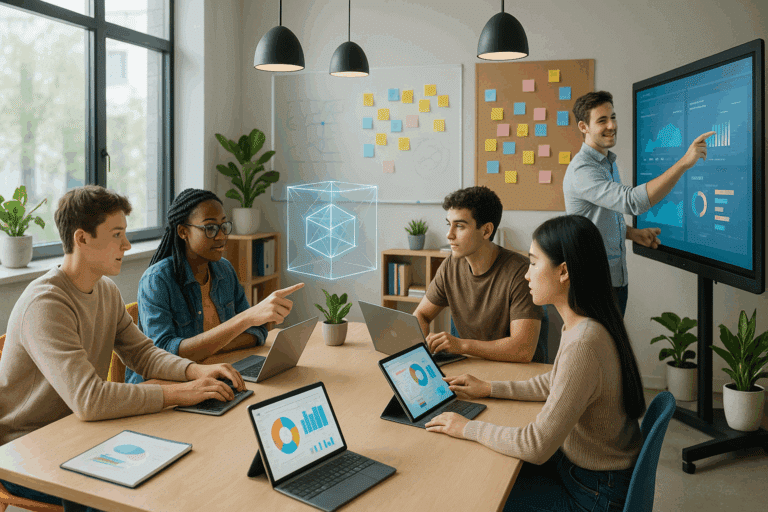Anúncios
Yet, when we delve deep into the realities of remote learning, the landscape is marred by challenges of accessibility, notably for individuals with different abilities.
The focal point of this comprehensive article is to break these barriers down and provide a clear, visual guide to accessible remote learning design. We will delve into the multifaceted aspects of remote learning, exploring not just the technical dimensions, but also the inclusivity and accessibility aspects. Our aim is to provide you with a holistic understanding, ensuring that your remote learning design is not just technologically sound, but also inclusive and accessible for all.
Firstly, we will analyze the importance of accessible remote learning design and why it has taken center stage in today’s digital education landscape. This includes understanding the unique challenges that individuals with different abilities face when it comes to remote learning, and why a one-size-fits-all approach simply doesn’t work.
Following this, we will delve into the principles of accessible remote learning design, providing you with a theoretical framework that you can use as the foundation for your design process. We will discuss the four primary principles of accessibility—Perceivable, Operable, Understandable, and Robust (POUR)—and how they translate into the context of remote learning.
We will then take a practical turn and provide a step-by-step, visual guide to creating an accessible remote learning environment. This guide will include practical tips and techniques that you can implement right away, along with real-world examples of accessible remote learning environments. The focus will be on ensuring that your remote learning design is not just accessible, but also engaging and effective for all learners.
Finally, we will wrap up by exploring some of the leading tools and technologies that can aid in creating accessible remote learning designs. These will range from authoring tools to Learning Management Systems (LMS), each with its unique features and benefits. This section will equip you with the technological know-how you need to bring your accessible remote learning designs to life.
Whether you’re an educator looking to make your remote lessons more inclusive, a software engineer tasked with designing a remote learning platform, or simply someone interested in understanding the complexities of accessible remote learning design, this article is for you. It’s designed to be a comprehensive, yet easy-to-understand guide to breaking barriers in remote learning design, ensuring that no learner is left behind in the digital education revolution.
So, let’s embark on this journey together, breaking down the barriers and illuminating the path to accessible remote learning design.
Breaking Through the Walls: Understanding Accessible Remote Learning Design
The global pivot to remote learning has brought into focus the importance of creating accessible and inclusive digital learning environments. While remote learning offers many benefits, it also presents unique challenges, particularly when it comes to accessibility. In this article, we will delve deep into the world of accessible remote learning design, providing you with a comprehensive visual guide to aid you in building a more inclusive learning space.
Before we delve into the core of the topic, let’s first understand what accessible remote learning is. Accessible remote learning ensures that all students, regardless of their physical, sensory, or cognitive abilities, can fully participate in their education. It encompasses a wide range of design principles, teaching strategies, and technological tools that work together to create an equitable learning experience.
This article will highlight key elements of accessible remote learning design, including the use of assistive technology, strategies for designing accessible content, and best practices for implementing accessibility features. Whether you are an educator, a software developer, or an educational institution, this guide will equip you with the knowledge you need to make remote learning more accessible for everyone.
Assistive Technology in Remote Learning: Tools and Techniques
Assistive technology is a crucial component of accessible remote learning. These are tools or devices that support students with disabilities in accessing and interacting with digital content. Assistive technology ranges from screen readers and magnification tools for visually impaired students to speech-to-text software for students with mobility or cognitive challenges.
For a comprehensive understanding, let’s dive into some of the key assistive technologies and their roles in remote learning. We will also provide links to instructional videos that demonstrate how to use these tools effectively.
Screen Readers and Magnification Tools
Screen readers are software applications that translate on-screen text into audible speech. They are indispensable for students with visual impairments, allowing them to navigate and interact with digital content. Some popular screen readers include JAWS, NVDA, and VoiceOver (built into Apple devices).
Magnification tools, on the other hand, enlarge specific parts of the screen, making it easier for individuals with low vision to read text and view images. These tools may also include features like high-contrast settings to further enhance visibility.
You can watch the video “How to Use a Screen Reader,” by the YouTube channel Perkins School for the Blind, to learn more about these tools.
Speech-to-Text Software
Speech-to-text software, also known as voice recognition technology, allows students to input text by speaking into a microphone. This technology is particularly beneficial for students with mobility challenges who may find typing difficult. Notable examples of speech-to-text software include Dragon NaturallySpeaking and Google’s built-in Voice Typing tool.
To understand how this technology works in practice, watch the video “How to Use Speech-to-Text Technology in Google Docs” by the YouTube channel TechRepublic.
Designing Accessible Content: Principles and Strategies
Designing accessible content is another critical aspect of accessible remote learning. Accessible content is content that is designed with the needs of all users in mind, regardless of their abilities. This means ensuring that text is easy to read, images are properly described, and interactive elements are accessible via keyboard commands.
Let’s explore some key principles and strategies for designing accessible content, as well as some examples of these principles in action.
Use of Alt Text and Captions
Alt text (alternative text) is a brief description of an image, which can be read out by screen readers. This allows visually impaired students to understand the content of the image. Similarly, captions provide a text description of the audio content in videos, making them accessible to students with hearing impairments.
For a visual demonstration of how to add alt text and captions, watch the video “How to Add Alt Text and Captions in Google Docs” by the YouTube channel BetterCloud.
Structured Content and Navigation
Structured content and navigation are important for creating a logical and predictable learning environment. Structured content involves organizing information in a logical, hierarchical manner, using headings, subheadings, bullet points, and other formatting tools. This makes it easier for all students, especially those using screen readers, to navigate through the content.
Navigation should also be keyboard-friendly, allowing students who can’t use a mouse to easily move through the content using keyboard commands.
Accessibility Features in Remote Learning Platforms
Remote learning platforms play a significant role in providing accessible learning experiences. Most modern platforms come equipped with built-in accessibility features. These can include options for adjusting font size and contrast, providing automated captions for video content, and supporting keyboard navigation.
While these features are a step in the right direction, there is still much room for improvement. Many platforms fall short when it comes to fully supporting assistive technologies and ensuring all content is accessible. Therefore, it’s crucial to choose a platform that is committed to improving its accessibility features and is responsive to user feedback.
To give you an idea of how different platforms measure up in terms of accessibility, we have created a comparison table below. This table examines the accessibility features of three popular remote learning platforms: Google Classroom, Microsoft Teams, and Canvas.
Anúncios
Platform
Font Size and Contrast Adjustments
Automated Captions
Keyboard Navigation
Google Classroom
Yes
Yes
Yes
Microsoft Teams
Yes
Yes
Yes
Canvas
Yes
No
Yes
Anúncios
As you can see, while all three platforms offer some level of accessibility, they each have their strengths and weaknesses. Therefore, it’s important to consider the specific needs of your students when choosing a platform.
Moving Forward: The Future of Accessible Remote Learning
The shift towards remote learning presents an opportunity to create more inclusive and accessible learning environments. By leveraging assistive technologies, designing accessible content, and choosing platforms with robust accessibility features, educators and institutions can make remote learning a more equitable experience for all students.
However, making remote learning accessible is not a one-time effort. It requires continuous learning, experimenting, and adjusting. As technology advances, new opportunities for enhancing accessibility will emerge. Therefore, it’s essential to stay updated on the latest trends and best practices in accessible remote learning design.
By focusing on accessibility, we can ensure that all students, regardless of their abilities, have the opportunity to learn, grow, and thrive in the digital age.
ConclusionIn conclusion, the central theme of our discussion throughout this article has been to provide an in-depth understanding of the often complex world of information technology and software engineering. This is not a straightforward subject matter, and our aim has been to explain the intricate technical details in a way that can be comprehended by professionals in the field, as well as by those who have a vested interest in learning more.
Our journey began with an exploration of the foundational aspects of software engineering, moving on to delving into the significance of coding and algorithm development, and culminating in an overview of how IT is transforming industries and reshaping the world as we know it. The importance of these topics cannot be overstated, and the profound impact they have on our everyday lives is undeniable.
Through examples, case studies, and comprehensive explanations, we have strived to present these technical concepts in an easily digestible format. Our goal is to reinforce the importance of these topics and to ensure that the information presented is not only educational but also engaging and insightful. (Computer.org).
In the rapidly evolving world of technology, staying updated is vital. The knowledge we have shared in this article is critical in the current technological landscape, and it is our hope that it will serve as a stepping stone for further exploration and learning.
But the conversation doesn’t end here. We encourage you to share your thoughts, questions, and insights in the comments section. Your input not only adds value to this discussion but also helps others by providing different perspectives and insights. (Turing.ac.uk).
Furthermore, we invite you to share this article with your colleagues and friends. The information here is invaluable, and sharing it contributes to a better understanding and appreciation of the significant role that information technology and software engineering play in our world. (SEI.cmu.edu).
Finally, we urge you to take the information learned in this article and apply it in your field, whether it’s in your current profession or as a part of your ongoing education. Knowledge is powerful, but its true value lies in its application.
In closing, remember that technology and software engineering are tools that, when used effectively, can lead to monumental advancements and success. So keep learning, keep growing, and let’s continue to push the boundaries of what’s possible together. (ACM.org).
Thank you for joining us on this exploration. We look forward to your contributions and to continue providing you with valuable insights in the future.
References:
1. Computer.org
2. Turing.ac.uk
3. SEI.cmu.edu
4. ACM.org



